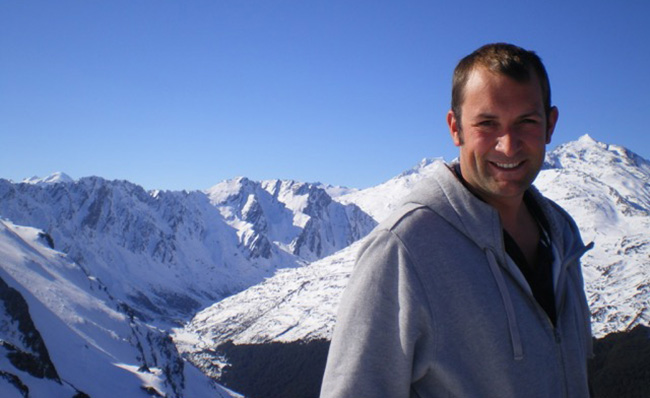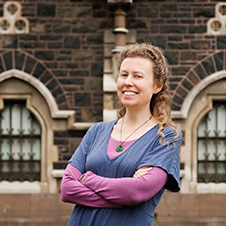 Friday 17 November 2017 2:29pm
Friday 17 November 2017 2:29pm
Dr Christian Ohneiser (pictured) and Dr Christina Hulbe are taking their research team to Antarctica.
After years of planning, a University of Otago-led research team is about to embark on an epic research expedition to the Antarctic to better understand how the earth's largest expanse of floating glacial ice will respond to global warming.
The multi-disciplinary and international team includes researchers from Otago, Victoria University of Wellington, Canterbury University, Waikato University, NIWA, GNS Science, Georgia Tech in the US, and the Chinese Polar Research Institute.
Next week when weather at Scott Base permits, the team will join engineers who have already journeyed to the field site at the Ross Ice Shelf, 350 kilometers away from Scott Base. The engineering team will assemble a New Zealand-built drill that will use hot water to bore through hundreds of metres of glacial ice to access the ocean and sea floor beneath their remote camp.
The team of 32 men and women will set up camp and tents for around five weeks, a period that includes Christmas day and New Year.
They are led and coordinated by Professor Christina Hulbe from Otago's Department of Surveying, and Dr Christian Ohneiser from Otago's Department of Geology. The expedition has taken more than two years to plan, for what will be a challenging and exciting programme of work.

Dr Christina Hulbe.
Professor Hulbe says the goal of the research programme is to understand the processes and ice/ocean interactions that matter most for change in the region, and locate all-important sediment deep beneath the ice to give clues to how the ice retreats.
“We know that in the past, climate warming caused ice shelf and ice sheet retreat in the Ross Sea. Now we need to find out more about the actual physical processes and the rates at which they act. We need to how all the different parts of the system, the ocean, the ice, the atmosphere, and even the sediments underneath the ice, work together. This kind of knowledge is essential to making better projections of future change,” says Professor Hulbe.
She emphasises that every member of the team is a leader.
“Our team seems large, but really, it's as small as it can be. We are working at the limits of what is possible, as efficiently and effectively as we can. It's an exciting place to work; the environment, the science, and the people are all excellent. ”
Dr Ohneiser adds: “The Ross Ice Shelf is a major interface between the West Antarctic Ice Sheet (WAIS) and the Southern Ocean.
“At the moment it appears to be stable but we can't tell for sure. What we do know is that it has changed quickly in the past. We need data from the places that are still covered by ice, not just from the easy-to-get-to places around the edge.”
The Ross Ice Shelf is Earth's largest expanse of floating glacial ice.
It is fed by glaciers flowing from the West Antarctic Ice Sheet and through the Transantarctic Mountains, and by new snow falling on its surface. The ice is continually moving, flowing away from the land and toward the open ocean, eventually breaking off as icebergs. The ice is moving nearly two metres per day at the drilling site.
Project scientists first visited the site two years ago, when they used seismic techniques to image the sea floor and install a weather station to monitor conditions. A team of three returned last year to recover data from the weather station.
This year's team is much larger, and comprises a 5-person drilling crew, 24 scientists, and three camp staff from Antarctica New Zealand.
The programme of work will last a lot longer, about 65 days all together.
Dr Ohneiser says not everybody will be at the camp at the same time.
“Two overland traverses are moving the heaviest equipment to the site, while most of the scientists and smaller gear will fly via a Twin Otter plane. The phased approach will help the team to manage resources and the camp's impact.”
He says the research itself will be complicated. Once the drilling crew has created the borehole, oceanographers and geophysicists will install instruments for long-term monitoring of conditions in the ocean cavity and the ice shelf.
Geologists will lower a core barrel down the hole to sample sediments on the sea floor. A remotely operated submarine on a three kilometer-long tether will dive down the borehole to observe ocean, sea floor, and ice conditions in the area all around the drill site. Back at the surface, an atmospheric physicist will install a regional network of smart weather stations and geophysicists and surveyors will use ice-penetrating radars and acoustic techniques to image internal structures of the ice shelf.
The Otago scientific team also includes Kelly Gragg, Holly Still, and Martin Forbes from surveying, Dr Sergio Morales from Microbiology, Dr Federico Baltar from Marine Science and Lisa Craw from geology.
Victoria University of Wellington Scientists are Dr Gavin Dunbar and Georgia Grant, Dan Lowry and drilling crew Alex Pyne (chief driller), Jane Chewings, Hedley Berge, Jeff Rawson and Darcy Mandeno.
The Canterbury University scientist is Dr Adrian McDonald, with NIWA scientists Dr Craig Stevens and Mike Brewer. The Waikato University scientist is Shelly Brandt, and Auckland University Scientists Dr Jennifer Eccles and Franz Josef Lutz.
And international collaborators Dr Britney Schmidt and her team (NASA, Georgia Tech, USA) and Prof Wei Luo from the Chinese Polar Research Institute.
The team will be joined by a journalist from New Zealand Geographic.
For further information, contact:
Professor Christina Hulbe
University of Otago
School of Surveying
Tel +64 3 479 7613
Or
Dr Christian Ohneiser
Department of Geology
University of Otago
Tel +64 3 479 7350
Mob +64 21 343 092
Email
A list of Otago experts available for media comment is available elsewhere on this website.
Electronic addresses (including email accounts, instant messaging services, or telephone accounts) published on this page are for the sole purpose of contact with the individuals concerned, in their capacity as officers, employees or students of the University of Otago, or their respective organisation. Publication of any such electronic address is not to be taken as consent to receive unsolicited commercial electronic messages by the address holder.